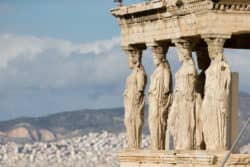 It has been a challenge for historians and archaeologists to piece together the history of Ancient Greece. Part of the problem is that there weren’t many known historians. Three of the most well-known were Herodotus, Thucydides, and Xenophon. Besides what they were able to report, all we know has been uncovered in temples, archaeological sites, and through sculptures, pottery, and other artifacts.
It has been a challenge for historians and archaeologists to piece together the history of Ancient Greece. Part of the problem is that there weren’t many known historians. Three of the most well-known were Herodotus, Thucydides, and Xenophon. Besides what they were able to report, all we know has been uncovered in temples, archaeological sites, and through sculptures, pottery, and other artifacts.
You might be wondering, what was Ancient Greece like? The answer is, it depends what time period of Ancient Greece it is. In order to truly understand what Ancient Greece was like, it helps to get an overview of the time periods, starting with the Neolithic Period and ending with the Hellenistic Period. Here’s an overview of the different time periods of Ancient Greece:
Neolithic Period (6000-2900 BC)
There weren’t always people living in Ancient Greece – they needed to travel to the region first. This happened during the Neolithic Period when people came to Ancient Greece from the East and they settled in the eastern portion of the region. Once these eastern settlements increased in population, the people scattered and traveled throughout Greece. They introduced pottery to Greece and began raising animals domestically. Over time, the people developed some settlements, including Nea Nikomedeia, Sesklo, Dimini, Franchthi Cave, and Athens.
Early Bronze Age (2900 – 2000 BC)
This is the time period in Greece when bronze and other metals like silver and gold were introduced to the people. They soon discovered that bronze and other metals could be melted and turned into ornaments, jewelry, knives, swords, and more. A class system also developed around the same time. This age extended into the Aegean islands and also the island of Crete, and the era began and ended at different times depending on where in Greece the people were located.
Minoan Age (2000-1400 BC)
 This civilization took place primarily on Crete. One of the best remnants of this civilization is the Palace of the Knossos near Heraklion on the island of Crete. The Minoans were perhaps most well known for their pottery and sculpture. They were a peaceful society who were also devoted to the arts. Many of the palaces that the Minoans constructed on Crete are still standing today, even if they are in ruins. This has enabled us to learn a bit about their way of life. It is thought that the civilization ended when the Mycenaeans attacked and conquered them.
This civilization took place primarily on Crete. One of the best remnants of this civilization is the Palace of the Knossos near Heraklion on the island of Crete. The Minoans were perhaps most well known for their pottery and sculpture. They were a peaceful society who were also devoted to the arts. Many of the palaces that the Minoans constructed on Crete are still standing today, even if they are in ruins. This has enabled us to learn a bit about their way of life. It is thought that the civilization ended when the Mycenaeans attacked and conquered them.
Mycenaean Age (1100 – 600 BC)
It is during this period that the culture of Ancient Greece truly started to develop, most especially the art and sculpture. They were successful builders and engineers and specialized in bridges, buildings, and palaces. Several important industries were in place such as the textile industry. In addition, the class structure developed even further.
The Dark Ages (1100 – 750 BC)
When the Mycenaean Civilization ended, it pushed Ancient Greece into a period known as the Dark Ages, which was a period of repression and economic uncertainty. It took hundreds of years for Greece to rebound from this. Also, in The Dark Ages, Ancient Greece was depleted by war and eventually invasion by the Dorians. After the Trojan War the Mycenaeans began a Civil War. Depleted from war, this gave the Dorians a chance to take over.
Archaic Period (750 – 500 BC)
The Archaic Period was most noted for the development of the arts even further, particularly through pottery and sculpture. Political theory also had its roots here as well as the idea of democracy. This idea was developed even further in the Classical Period.
Classical Period (500 – 336 BC)
 This was a thriving era in Ancient Greek history. One of the most important developments was the full creation and implementation of the democratic system. This era also saw the building of the Parthenon and conflict with neighboring empires such as the Persian Empire. This is the time that people refer to as the Golden Age of Ancient Greece.
This was a thriving era in Ancient Greek history. One of the most important developments was the full creation and implementation of the democratic system. This era also saw the building of the Parthenon and conflict with neighboring empires such as the Persian Empire. This is the time that people refer to as the Golden Age of Ancient Greece.
Hellenistic Period (336 – 146 BC)
As you can see, this time period doesn’t span a large time period. Greek culture was further shaped during this time and the people valued learning. This is the short time period between when Alexander conquered the Persian Empire. This period was fairly short, but many of the aspects of the Greek culture that we know of were developed here.
There have been many time periods in Ancient Greek history. This article provides you with a starting point so that you can get an overview that will allow you to understand Ancient Greek history more fully.
Source:

